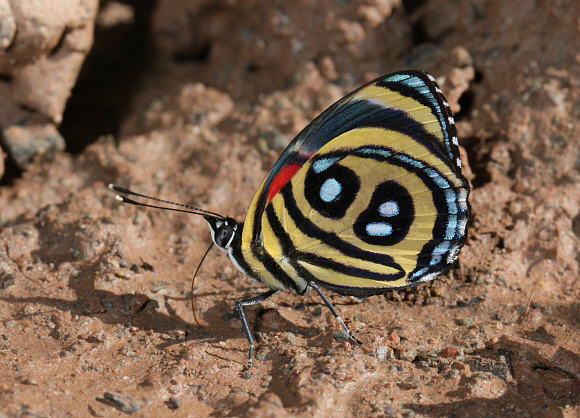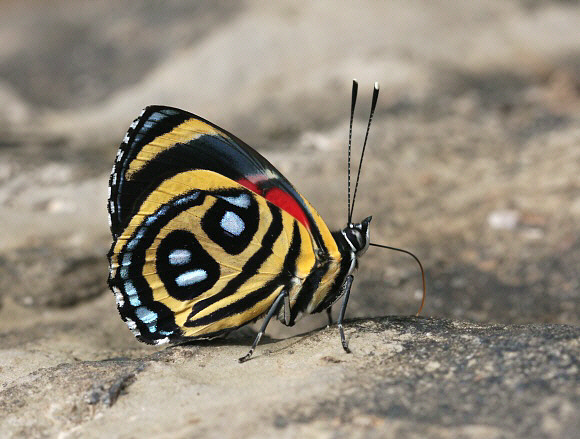 Paulogramma pyracmon peristera, Catarata Bayoz, Le Merced, Peru – Adrian Hoskins
Paulogramma pyracmon peristera, Catarata Bayoz, Le Merced, Peru – Adrian Hoskins
Introduction
The genus Paulogramma contains a single species, pyracmon, which was formerly placed in the closely related genus Callicore ( syn. Catagramma ). Butterflies of both genera are marked on the underside hindwings with bold black alpha-numeric symbols on a cream or yellow ground colour, and have metallic blue submarginal bands. The easiest way to distinguish this species from it’s cousins is to look for the “flipped over” section of the blue submarginal band, which in pyracmon enters the “O” of the alpha-numeric.
The upperside forewings of pyracmon are black, marked with a with a large bright red swatch in the basal area. The hindwings are dark earthy brown, marked with either a large circular red swatch in the male of the Peruvian / Bolivian subspecies peristera; or with a blue swatch in males of the Brazilian subspecies pyracmon. In females of both subspecies the upperside hindwings are dark brown, marked with a narrow, broken, blue submarginal band.
This species is found in the upper Amazonian region of Brazil, Ecuador, Peru and Bolivia.
 Paulogramma pyracmon peristera, Catarata Bayoz, Le Merced, Peru – Adrian Hoskins
Paulogramma pyracmon peristera, Catarata Bayoz, Le Merced, Peru – Adrian Hoskins
Habitats
Tropical rainforest at altitudes between circa 200-800m. In common with other members of the tribe Callicorini, males of this species are frequently found close to habitations, where they are attracted to urine-tainted ground, seepages, and human sweat.
Lifecycle
Unknown.
 Paulogramma pyracmon peristera, Satipo, Peru – Adrian Hoskins
Paulogramma pyracmon peristera, Satipo, Peru – Adrian Hoskins
Adult behaviour
The butterflies are usually encountered as solitary individuals, often in company with groups of Callicore, Diaethria and Panacea. They have a rapid flight over short distances, circling just above the ground, but then often soaring rapidly up to settle of tree foliage.

Paulogramma pyracmon peristera, Rio Pindayo, Peru – Adrian Hoskins
